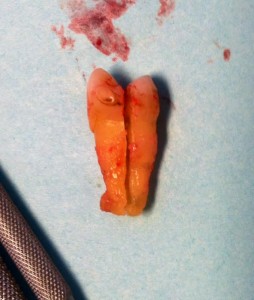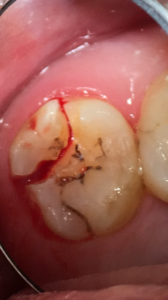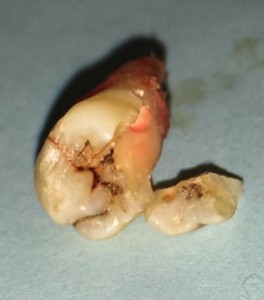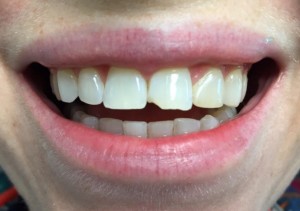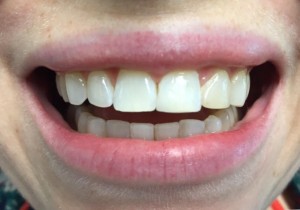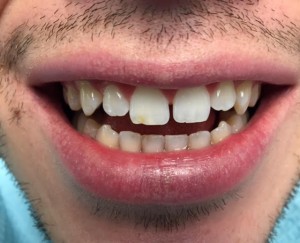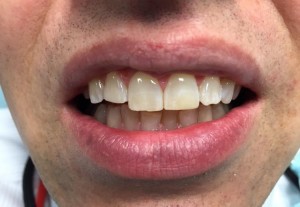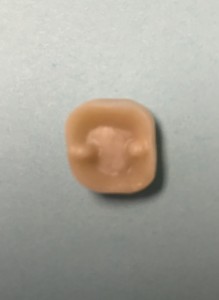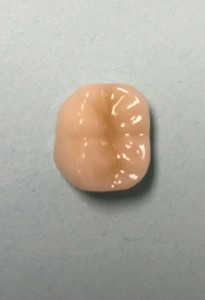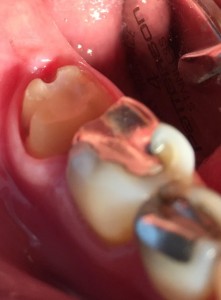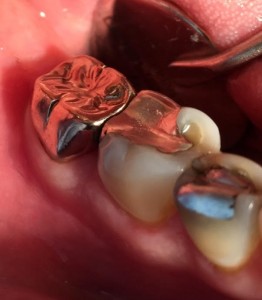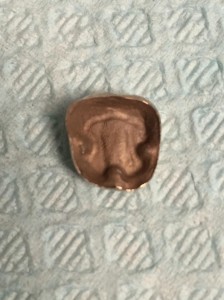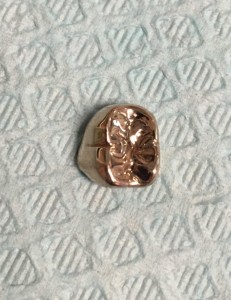This patient today chipped her front tooth biting a coffee stirrer straw. I was able to restore the tooth with a bonded composite restoration in 30 minutes. Looks great!!!
Tag Archives: cracked tooth
Friday afternoon chipped and broken teeth.
Thursday morning chipped tooth.
Fractured teeth of the day. Every day I see broken teeth. Here are 2 examples from today.
This patient cracked his molar biting a chicken bone. I was able to save the tooth, and without a root canal, but it did require a crown lengthening periodontal surgery and a crown.
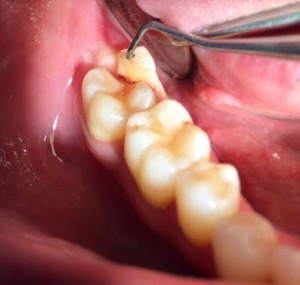



This next patient bit down on a mint candy and fractured her molar down the root. The tooth could not be restored and was extracted and we will place a dental implant.
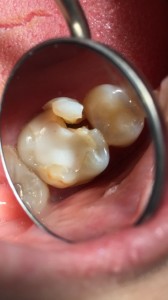
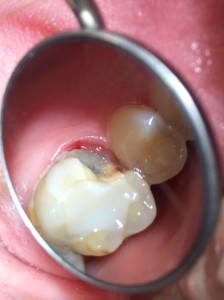
Retention Grooves to help crowns last longer.
On these 2 crowns, the first porcelain and second gold, that I did last week in my office I show how I place retention grooves in my crown preparations to help lock my crowns in. These grooves prevent rotation and help secure the crowns in place. These slots allows for more surface area for the cement and results in a longer lasting restoration that holds firmly in place. This is especially important in short weak teeth. With this technique I am able to save teeth that otherwise would need to be extracted or require periodontal crown lengthening surgery.
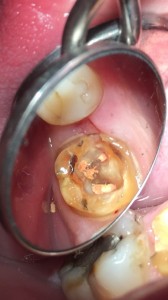

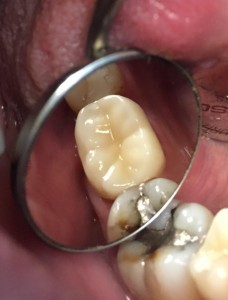
Fractured molar
This patient fractured the lingual side of his first molar tooth biting down on a Skittle candy. Dr. Gentry was able to restore the tooth with a porcelain crown and was able to avoid a root canal and crown lengthening periodontal surgery.

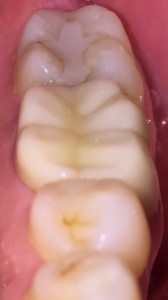
Root canals explained.
What is a root canal?

To understand root canal treatment, it helps to know something about the anatomy of the tooth. Inside the tooth, under the white enamel and a hard layer called the dentin, is a soft tissue called the pulp. The pulp contains blood vessels, nerves, and connective tissue and creates the surrounding hard tissues of the tooth during development.
The pulp extends from the crown of the tooth to the tip of the roots where it connects to the tissues surrounding the root. The pulp is important during a tooth’s growth and development. However, once a tooth is fully mature it can survive without the pulp, because the tooth continues to be nourished by the tissues surrounding it
Why would I need a root canal?
A root canal is necessary when the pulp, the soft tissue inside the root canal, becomes inflamed or infected. The inflammation or infection can have a variety of causes: deep decay, or a crack or chip in the tooth. In addition, an injury to a tooth may cause pulp damage even if the tooth has no visible chips or cracks. If pulp inflammation or infection is left untreated, it can cause pain or lead to an abscess.

What are the signs of needing root canal treatment?
Signs to look for include pain, prolonged sensitivity to heat or cold, tenderness to touch and chewing, discoloration of the tooth, and swelling, drainage and tenderness in the lymph nodes as well as nearby bone and gum tissues. Sometimes, however, there are no symptoms.
How does root canal treatment save the tooth?
The dentist removes the inflamed or infected pulp, carefully cleans and shapes the inside of the root canal, then fills and seals the space. Afterwards, a crown or other restoration on the tooth to protect and restore it to full function. After restoration, the tooth continues to function like any other tooth.
Will I feel pain during or after the procedure?
Many root canal procedures are performed to relieve the pain of toothaches caused by pulp inflammation or infection. With modern techniques and anesthetics, most patients report that they are comfortable during the procedure.
For the first few days after treatment, your tooth may feel sensitive, especially if there was pain or infection before the procedure. This discomfort can be relieved with over-the-counter or prescription medications. Your tooth may continue to feel slightly different from your other teeth for some time after your root canal treatment is completed.
Step-by-Step Root Canal Procedure
Root canal treatment can often be performed in one or two visits and involves the following steps:

1. The dentist examines and x-rays the tooth, then administers local anesthetic. After the tooth is numb, a small protective sheet called a “dental dam” is placed over the area to isolate the tooth and keep it clean and free of saliva during the procedure.

2. An opening in the crown of the tooth. Very small instruments are used to clean the pulp from the pulp chamber and root canals and to shape the space for filling.

3. After the space is cleaned and shaped, the dentist fills the root canals with a biocompatible material, usually a rubber-like material called gutta-percha. The gutta-percha is placed with an adhesive cement to ensure complete sealing of the root canals. In most cases, a temporary filling is placed to close the opening. The temporary filling will be removed usually 1 week later.

Can all teeth be saved with a root canal?
Most teeth can be saved. Occasionally, a tooth can’t be saved because the root canals are not accessible, the root is severely fractured, the tooth doesn’t have adequate bone support, or the tooth cannot be restored.
Here’s photos of what an actual root canal looks like on a patient.
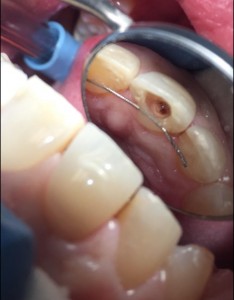
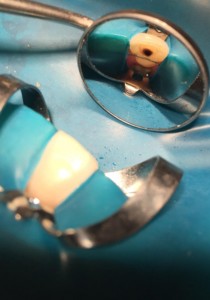
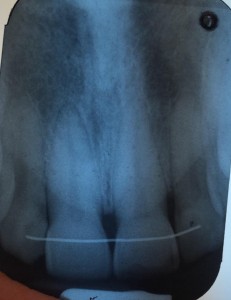

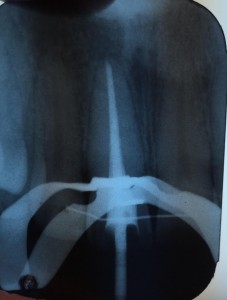
Cracked teeth/tooth fractures.
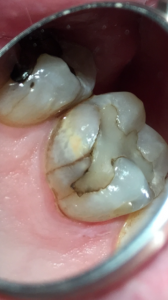
If when you bite down, you feel a sharp pain you may have a cracked tooth. A tooth crack may have been caused by:
- Chewing on a hard object or food such as ice, nuts, candy, or popcorn.
- An accident, like a blow to the mouth.
- Grinding or clenching your teeth.
- Weak tooth caused by wear or large old fillings, or root canal.
If you feel pain when you bite down on a tooth please let Dr. Gentry know and he will evaluate the tooth and discuss the best treatment protocol for you. If treated early, the cracked tooth possibly can be treated with a bonded filling or a crown. If the crack is deeper the tooth may require a root canal or even extraction.
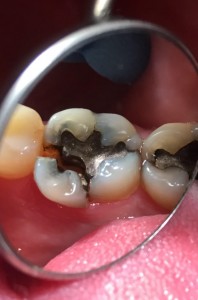
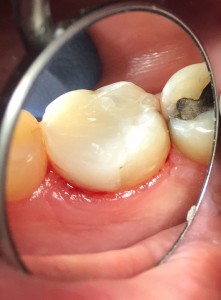
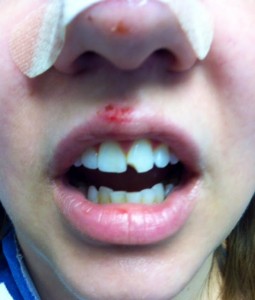
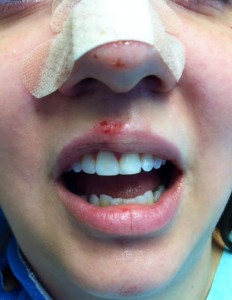
If the crack is deep or extends down the root, the tooth may need to be extracted.


